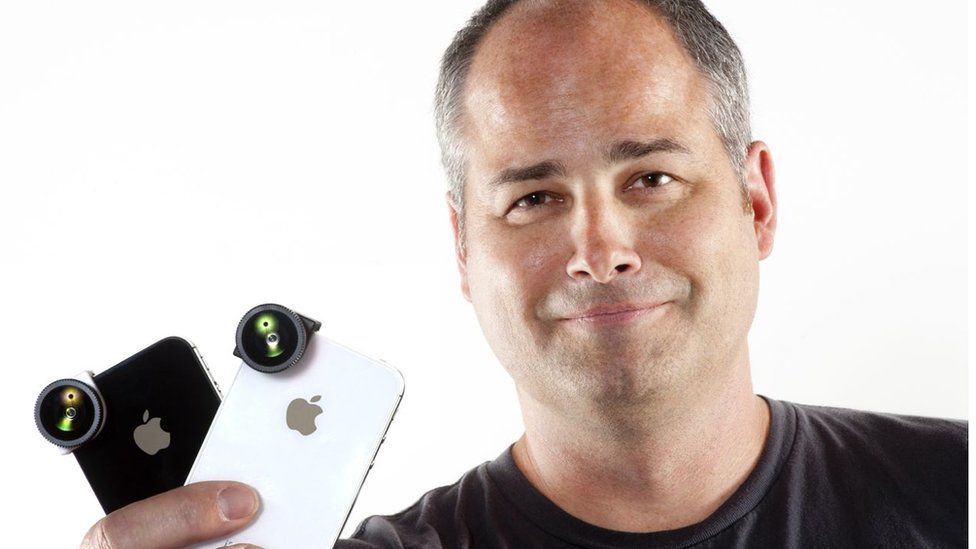The man who bet his house on his mobile phone invention
- Published

Patrick O'Neill bet his house on people wanting to upload better quality photos to their social media pages.
The 50-year-old amateur photographer had been inventing and building computer devices for years when he first got the idea for a camera lens that attaches to a smartphone.
Mr O'Neill could see the growing competition to have the best Facebook and Instagram pictures, and guessed that social media shutterbugs would want a tool that gave their snaps an edge.
He was right, and not only did fellow amateur photographers want to buy his lenses, they were willing to help him finance the start of his US company.
A 2011 crowdfunding campaign on Kickstarter, raised more than $68,000 (£47,786) from 13,000 backers.
Mr O'Neill then added to that sum with a $200,000 loan he took out against the value of his home in Orange County, California, and his Olloclip business was born.
He says the loan was a gamble worth taking.
"I didn't sit down with my family and say 'look I took this loan and if this fails we could lose the house'," says the married father of three. "I didn't believe that would happen."
Thankfully for Mr O'Neill, his bet paid off. His company has now sold more than 1.5 million Olloclips, with sales growing close to 20% each year.
Personal inspiration
The Olloclip is a camera lens attachment for your smartphone.
It clicks into place over the handset's built-in camera lens, changing the angle and focal length of the picture that the phone takes.
The firm's bestselling "4-In-1 Lens" Olloclip comes with four lenses - fisheye, wide-angle, and two macro lenses for close-up photos.
Mr O'Neill, who previously managed his own computer device building business, making hard drives, monitors and other equipment for companies, also got inspiration for Olloclip from his own needs and wants as an avid photographer.
Growing up he and his grandfather would go out to take photographs and videos.
As an adult he carried bags of camera equipment and lenses for his digital SLR camera with him on every trip. He longed for a solution that would allow him to shoot the images he wanted without carting around a heavy backpack all the time.
So he came up with the idea of adding an external lens to his iPhone.
Olloclip today employs 50 people, and assembles its products at its southern California factory using glass lenses from China.
The company's biggest challenge is keeping up with the changing designs of smartphones. For each new phone release it has to create a new Olloclip that fits.
In an attempt to be as quick to market as possible, it 3D prints what it expects the latest phone releases to look like, and tests Olloclip designs on them.
The company is also now expanding to sell cases and photography accessories.
Mr O'Neill says: "Everything we are going to do is based around mobile photography.
"We want to move what people do with their smartphones forward, and we don't want to do stuff that is boring."
Steve Jobs influence
Although Olloclip does make two models for the Samsung Galaxy phone, the remainder of its products are all designed for Apple's iPhone or iPad tablet computer.
Mr O'Neill says it was a business decision to focus primarily on Apple because Apple's customers spend far more on phone accessories than owners of other smartphones.
He also admits that he is a big Apple fan himself.
"Apple products have been a huge influence on my life," says Mr O'Neill. "Every time I design a new clip I think about what Steve Jobs would say."
Apple has also helped Olloclip's growth. The lens are sold in Apple stores, which has helped them reach a wider market.
According to Joshua Goldman, an editor at tech-news website CNET, the Olloclip is popular because it offers better quality than cheaper competitors, but is not so expensive that it is out of reach.
"When you consider that most people look at how good the camera is when they buy a new phone, it makes sense that people look for things that make this experience even better," says Mr Goldman.
Healthcare use
Though Olloclips are most often used for Instagram photos, they have also been tasked with more noble work.
Olloclips were sent with doctors to Nepal to help them diagnose and treat eye conditions. The doctors used the Olloclip's macro lens to take magnified pictures of villagers' eyes, in areas where they could not get heavy diagnostic equipment.
Using the Olloclip the ophthalmologists in the field were able to send images back to colleagues in the US to get second opinions in tough cases.
Scott Hamilton from charity Dooley Intermed International, which led the expedition, says the Olloclips were a cheaper option than traditional equipment.
"Even if we could get a good image on ophthalmology equipment, we didn't have a way to get that image swiftly back," says Mr Hamilton.
The expedition did not have access to a strong internet connection either, but they did have mobile phone signal allowing them to send their Olloclip pictures back with a text message right away.
Mr O'Neill says: "My pet project is to find other uses for Olloclips.
"I think taking beautiful photos is great, but if we can help with rural medicine, or lower the cost of doing research in places where they don't have a lot of money, I think it's really special."